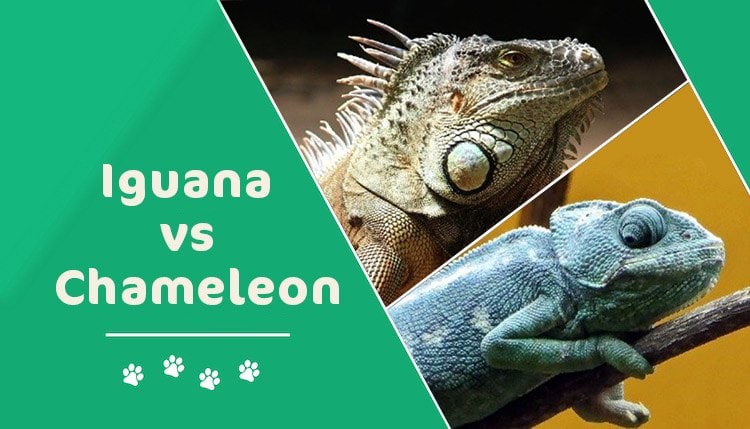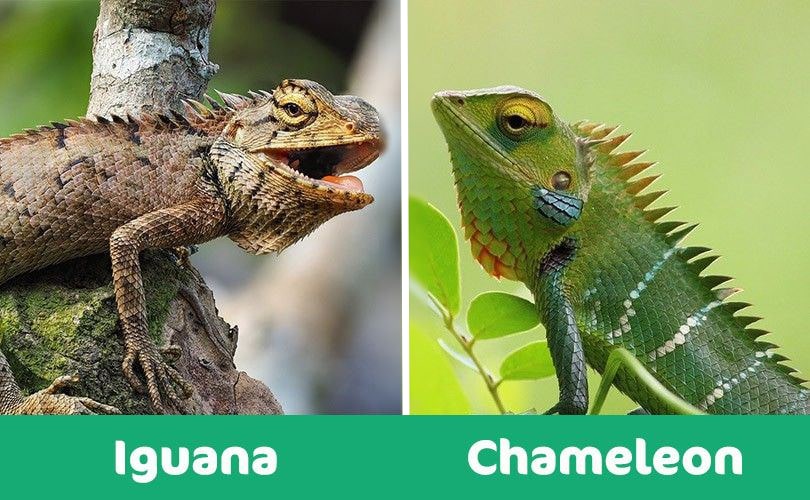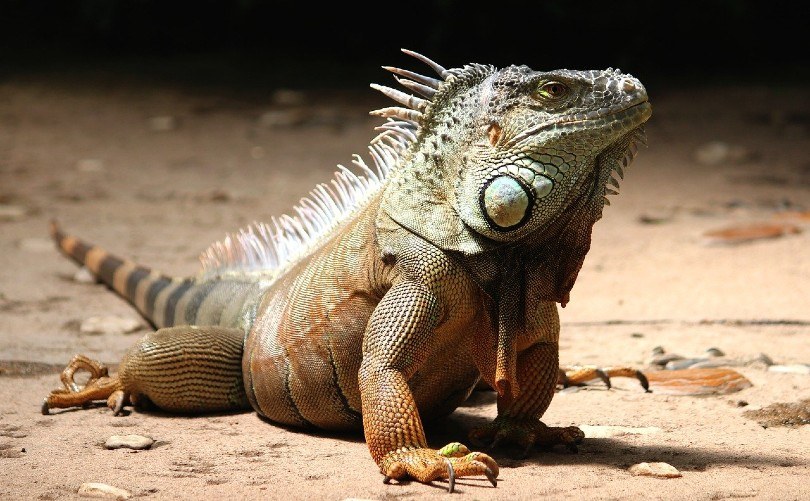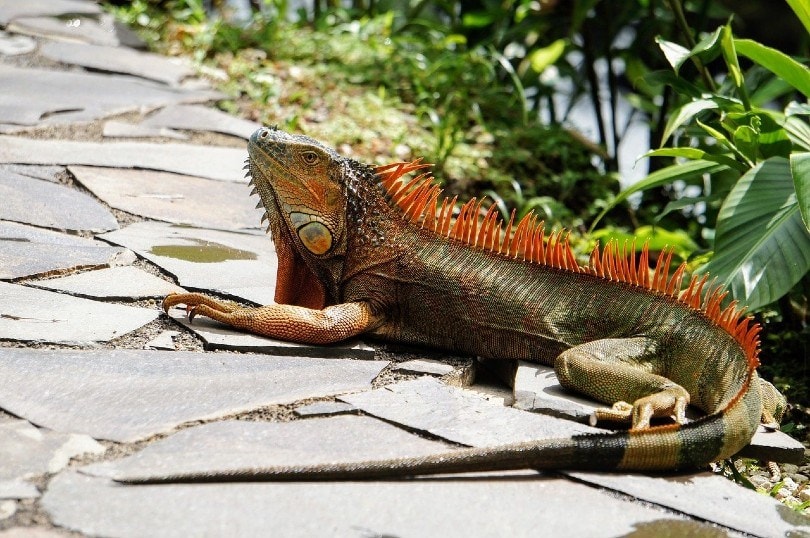Is the Chameleon or Iguana More Easy to Take Care of

Both are reptiles and both are popular breeds to keep as pets. However, the iguana and the chameleon are quite different species.
Iguanas are herbivores and they live on land as well as up in trees.
Chameleons are carnivores and live in trees, and they are capable of changing their color: something that the iguana is unable to do. Iguanas are, generally, much larger than chameleons and they have spiny crests on their back. Some chameleons do have crests, but many do not, and these crests tend to appear on the top of the head rather than on the back.
Both species have essentially adapted and evolved to survive in their common habitat. If you are looking for a pet lizard, the iguana's herbivore tendencies mean they are preferred by owners that do not wish to feed live food. The iguana can be tamed with enough handling and time between owner and lizard, but the size of the iguana means that they are not considered the best pet for most living conditions and homes. The chameleon, on the other hand, should be left in his cage and not handled except when necessary.
Read on to learn about some more of the differences between these two unique species.

Visual Differences

At a Glance
Iguana
- Average height (adult): 50-74 inches
- Average weight (adult): 10-35 pounds
- Lifespan: 15-25 years
- Exercise: 1-4 hours a day
- Grooming needs: Claw trimming, bathing, shedding, sneezing
- Family-friendly: Yes
- Other pet-friendly: Usually
- Trainability: Basic training requires time
Chameleon
- Average height (adult): 12-20 inches
- Average weight (adult): 1–6.3 ounces
- Lifespan: 3–10 years
- Exercise: Minimal
- Grooming needs: Shedding
- Family-friendly: Yes
- Other pet-friendly: Not usually
- Trainability: Barely

Iguana Overview
There are, in fact, more than 30 known species of iguana. Most originate from Central America, Mexico, and Brazil. They live in hot areas, near water, and like most lizards and pets, they need you to replicate their natural environment to lead a long and healthy life at home. With regular handling, they can become a friendly and central figure in the family, getting along with children and other animals, but some breeds can grow up to 6 feet in length, so they will need a substantial amount of room in which to live. They also take some grooming and caring, and they need regular handling and socialization throughout their 20-year life to ensure that they remain a safe family pet.

In The Wild
The green iguana is the most common species of wild iguana. They live in treetops in the Americas, although they may also live in some open areas. They do live near water and make excellent swimmers and divers. Surprisingly fast and agile on land, the iguana is also built to fight back if predators attack. They have whip-like tails and very sharp teeth. If they do get caught by a predator, they can detach their tail and regrow another without too much difficulty or harm.
Personality / Character
Iguanas are among the most common and popular reptile pets, along with chameleons. Babies can be quite fast and agile while adults become more docile, especially if they are comfortable in their surroundings and with their family. Your iguana may choose to climb on you when out of his cage. He does have sharp claws and so you will need to wear thick clothing. You should also be aware that, while it is rare, an iguana can break a human bone with its tail.
Training
An iguana cannot be trained, in the sense that you will never convince them to roll over or to lay down on command. However, with regular and careful handling, this lizard will accept being picked up and handled by his human owners. They may resist, at first, because it is unnatural for them. Do not try and force the issue, but take things slowly and steadily, and encourage your pet iguana with some insect treats.

Health & Care
Possibly the most significant factor to consider is the size of the iguana. It can grow to sizes of up to 7 feet in length, including its tail, and can weigh upwards of 20 pounds. Most owners give their iguana their own room, but he will also need a substantial cage. This needs adequate lighting, graduated heating between 75 °F and 95 °F. You will also have to ensure that the humidity remains high, typically above 70%, and that you offer plenty of elevated positions and things for your skilled climber to climb.
When it comes to diet, the iguana is a strict herbivore. He will avoid eating animal protein, which can make him quite sick, and combine a pelleted diet with leafy greens, fruit, and appropriate supplements. Iguanas do not chew, so all food needs to be carefully prepared into suitable bite-size chunks.
Suitable for:
The iguana is a suitable pet for a family with plenty of spare room as well as a lot of time to spend bonding with the lizard. He is a good choice for those that do not want to feed live food or meat protein to their pets, and he can become quite affectionate with regular and careful handling. The iguana is not as suitable for keeping in a cage and out of the way of the family.
Related Read: Bearded Dragon vs. Iguana: Which Pet is Best for You?

Chameleon Overview
While the iguana is a large pet that benefits from time in and out of its cage, the Chameleon is much smaller and should be considered a glorious sight to behold, but not to hold. They are shy lizards that are very easily stressed, and when stressed, the chameleon can become ill and may die. This, coupled with the difficulty of providing a suitable home for an arboreal creature that lives primarily up trees, means that the chameleon is not necessarily a good pet for first-time herpetologists. In fact, in many respects, and despite the iguana being considerably larger, it may be considered the better lizard for first-time owners.

In The Wild
Chameleons are arboreal, which means that they live up and on trees. They will need a lot of foliage and a cage that offers vertical space, as well as horizontal. They prefer warm climates and can live in any habitat from desert to rainforest. They have been found in Africa, Madagascar, Europe, and even in southern Asia. They have very long tongues, and usually have eyes that operate independently of one another. Their most noteworthy characteristic is the fact that they can change color, although their color is usually determined by their mood rather than the color of their background.
Personality / Character
Timid and shy creatures, chameleons should not be considered pets to be taken out and handled. They are similar, in this respect, to fish. They are beautiful and intriguing lizards that are amazing to observe, but they should not be handled. They are very easily stressed, and this can lead to illness and even death, and being picked up and carried around is one of the ways this breed can become stressed.
Training
You cannot train a chameleon, although they are likely to learn feeding times and rituals. If you feed on a routine, you can expect your chameleon to be ready for the introduction of food.

Health & Care
Several factors need to be considered when taking on a chameleon. They are tree-dwelling creatures that are usually solitary. You will have to provide a substantial amount of cage space for a single animal that you will not be able to get out and handle, and it is worth bearing this in mind when thinking about your first lizard. They need a lot of foliage. Ensure that the plants are non-toxic. They will also need basking areas, with some chameleons preferring higher temperatures than others. They will not usually take water from a dish, so you can use ice cubes that drip onto leaves, or a dedicated dripping system. Misting will also help maintain a high humidity level. Chameleons need UVA and UVB light.
They do eat insects, including crickets and mealworms, and these should be gut loaded with calcium before feeding. Incorporate leafy greens and some vegetables.
Suitable for:
Owners that want cage-based lizards with plenty of unique characteristics and traits, but that should not be handled or removed from the cage except when necessary. The cage itself is large, especially for only one chameleon, but the investment is worth it to see the incredible eyes and the color-changing nature of the chameleon lizard.

Which Breed is Right For You?
Chameleons and iguanas are popular pets, and despite both being lizards, they are very different animals with different requirements and offering a different pet-owning experience. The Iguana can be a sociable animal that will, with regular and ongoing handling, enjoy some human attention. The chameleon, on the other hand, should not be handled and should be left in his cage so that he doesn't get stressed or ill.
Both require a lot of room. The iguana can grow to 7 feet in length, so he will need plenty of room just to walk around. While the chameleon is much smaller, he needs branches, foliage, and other levels on which to climb and bask, so he will need a substantial amount of cage room. Both lizards have unique features, including the chameleon's color-changing and unique eyes, and both make excellent pets, but they also require a major commitment and a lot of effort.
- Related Read: 7 Best Substrates for Iguanas 2021
Source: https://petkeen.com/iguana-vs-chameleon/
0 Response to "Is the Chameleon or Iguana More Easy to Take Care of"
Post a Comment